Chinese Institute of Archaeology
Source - http://www.kaogu.cn/en/detail.asp?ProductID=4467
During the Warring States Period, Qin and Han Dynasties, development of smelting technology in this period is regarded as a prominent stage of the ancient Chinese handicraft. In this period, the development of ancient bronze smelting has developed gradually into a new stage and the iron industry is also reaching maturing. As a matter of fact, the productivity in the society has been growing rapidly together with economics and social development. In order to intensify the scientific research of the bronze smelting and iron industry during the Warring States Period, Qin and Han Dynasties, the Institute of Archaeology CASS, the Shandong Provincial Institute of Archaeology and Cultural Relics together with the Cultural Relics Bureau of Linzi District have jointly launched an archaeological survey cum excavation focused on the smelting site within the Qi’s capital of Linzi in Shandong recently.
The Lingzi was the capital of Qi state during the Dynasties of Western and Eastern Zhou, it was also a prefecture and feudal state during the Qin and Han Dynasties. Besides, it was also known as the “Metropolitan of the East” during the Warring States period because of the rapid industrial and commercial growth. Therefore, remains of various handicrafts including bronze smelting and iron industry were unearthed during the previous archaeological excavations. From 2011, the project has conducted a comprehensive research focusing on the smelting industry within the ancient Linzi city. The investigated areas include the entire city as well as its surrounding environs and 14 smelting sites have been identified. The dating ranged from Eastern Zhou to Qin and Han Dynasties. Findings including bronze smelting workshop, coin workshop as well as iron casting processing workshop and iron producing workshop. Meanwhile, an extensive investigation and prospection were conducted in Kanjiazhai village with an area around 600,000 sq. meters with rich smelting features, especially a bronze mirror producing and iron smelting workshop located at the southeastern region in the village.
Three locations were excavated from 2012 Autumn to 2013 Spring in the southeastern area of Kanjiazhai village with the authorization of the State Administration of Cultural Heritage. A number of important relics and features dated the Warring States Period, Qin and Han Dynasties were unearthed.
Identified features including casting pit, kiln, stove, iron slag deposit, as well as house foundation, well, ask pit, road and children burial.
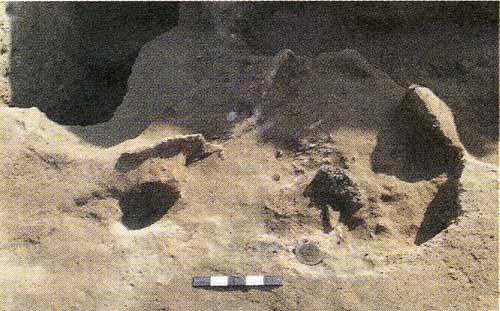
The casting pit remain ZK1
The casting pit remain (ZK1) was located at Area II and was in irregular shape. Associated finds and features with the bronze mirror produce were also identified including sand pit, mould for mirror and copper slag within and beside the pit. With the analysis from the features and finds unearthed in the surrounding, it is confirmed that this is a casting bronze mirror workshop site. The excavation of ancient mirror-casting workshop was the first of its kind in mainland.
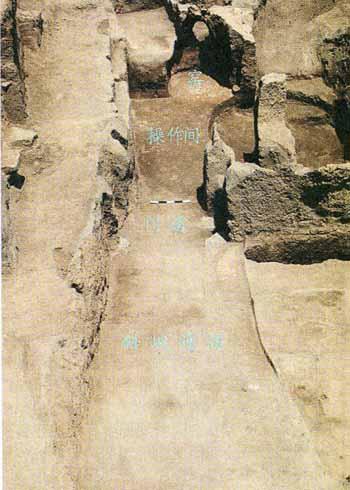
Kiln remain Y
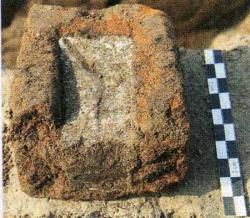
Pottery casting mould from kiln Y15
A number of kilns were different in terms of their form and structure, which may associate with the manufacturing of mould or other smelting and casting process. A semi subterranean kiln (Y15) was located at Area II, which was constructed by rammed earth from top to bottom. The length of the kiln was 10m measured south to north and formed by four components namely the slope passage way, doorway, operating room and kiln body. The depth of the operating room was around 1.1m. A layer of yellow mud was plastered in the walls of the slope passage way, doorway and operating room. Several postholes were identified in the east and western side walls. Most of these postholes contained foundation stone. From those, one can see that there exist the facilities like the roof on the top. The kiln body was constructed by mud brick. The opening of the firebox faced directly to the operating room and the back was in ladder shape upward,through which it is believed that these were for kiln bed usage, upon these attached with a flue pipe.
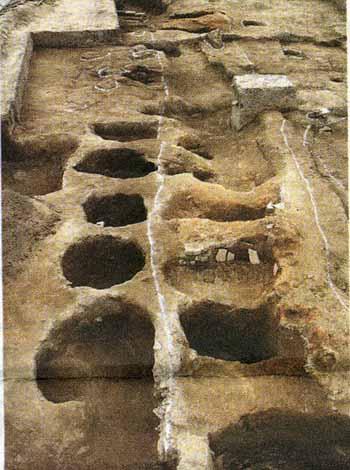
Kiln-shaped features correstponding with circular pits
A group of kiln-shaped feature was identified in Area I from west-eastern side in a linear alignment and corresponding a circular pit in the northern part of each kiln. In one of the well preserved kiln, it was in oval shape from south to north with 1m length and its remaining depth was 0.3m. An opening from the north measured 0.4m in length and 0.24m in width was identified. The kiln chamber and the opening were made of bricks. Iron slag deposit piled up was only found in Area III and mixed with stove wall fragments, which were presumably associated with smelting and casting iron and other producing activities. For the house remaining, which remain only ground parts, some of them contained foundation stones. According to its space relationship with other remains, some houses can be treated as the workshop at that time.
Large number of ash pits was identified filled with manufactured and daily wastes. Only few of the pits contained raw materials for manufacturing purpose. The clay materials with special type and color were found within the pit, and it is assumed that those are related to the raw materials for producing pottery mould and other wares. The findings are in a great variety including copious amount of tiles, bricks as well as different type of pottery, bronze, iron, bone, jade, tiles-end, coins, textiles and casting-mould, fire resistant bricks, pipe blast, copple, stove wall remains, copper and iron slags which related to smelting and casting.
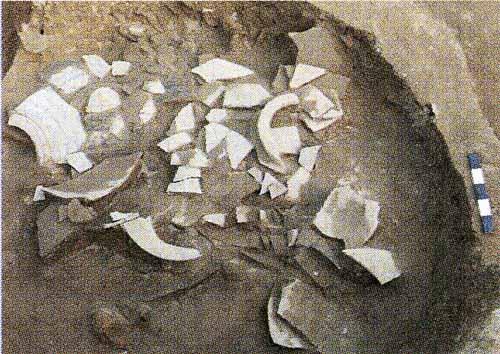
Pottery fragments from ash pit H10
Different types of pottery were identified and some of them were in huge size, for example, the Weng urn and Zeng steaming-pot unearthed in H10, the diameter of some belly is more than 1m, which were definitely the containers being used in the workshop. There were more than 200 stone and pottery moulds located in Area II. Stone mould was rarely seen and most of them were for Banliang coin. For the copious pottery moulds, most of them were for bronze mirror, in addition, some of them for horses and chariots devices and other tools.
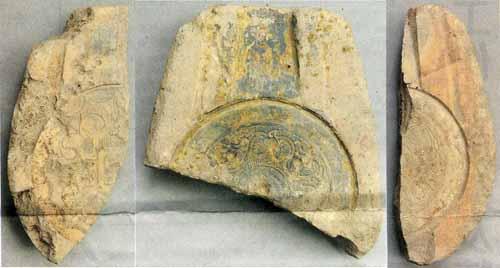
Pottery moulds for bronze mirror
Other than that, large amount of animal and plantation remains were identified. These remains were mainly skeletons of various animals, tooth, carbonized nuts and grains, etc. It was also the first time to discover the squid skeleton in Chinese archaeology. The information provided profound scientific values in understanding the natural environment as well as the lifestyle of craftsman and ordinary people in that particular period.
The excavated smelting and casting site can be dated from the Warring States period to Western Han. A number of profound features such as mirror casting workshop in Area II excavated point dated early Western Han was identified. Judging from the excavated smelting and casting remains, it can be confirmed that a gigantic smelting and casting handicraft workshop was once located in the excavation area as well as its surrounding during the Warring States Period, Qin and Han Dynasties. These findings provide valuable information for studying the bronze smelting and iron industry in terms of their technology. This is the first time that a bronze mirror workshop is discovered and is regarded as a great breakthrough of the study on ancient bronze mirror manufacturing and casting technology. (Translator: Andy Yiu)